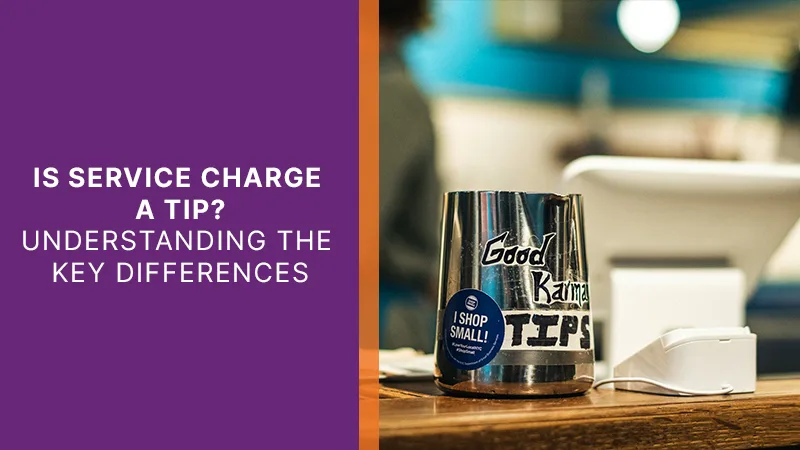Breaking Down Restaurant Service Charges
As more restaurant service charges show up on customers’ bills, so do the questions. Is a service charge the same as a tip? What’s the difference? And why does it matter? Understanding what a service charge really is helps clear up misunderstandings and ensures everyone, including customers, staff, and restaurant owners, is on the same page.
Let’s clear it up: service charges are not tips, and confusing the two can get your restaurant business into hot water with the Internal Revenue Service. A restaurant service charge (also called a service fee) is a mandatory fee added to a customer’s bill. While a tip is optional and based on the customer’s judgment, a service charge is set by the restaurant and applied automatically. These charges are often used to cover rising labor costs, employee healthcare, and other operating expenses.
With minimum wage hikes and inflation pushing up the cost of food and staffing, many restaurants are turning to service charges to avoid having to raise menu prices across the board. But this move requires clarity. If customers don’t understand why the fee is there or how it’s used, it can lead to frustration or mistrust. That’s why consistent policies and open communication are key to making service charges work for both the business and the people it serves.
At SynergySuite, we work with restaurant owners who are navigating complex compliance, cost control, and labor issues. Understanding the distinction between service charge and tip is more than a technicality. It’s about protecting your restaurant, supporting your employees, and maintaining customer trust.
What is a Service Fee?
A service fee, also known as a service charge, is a mandatory payment added to the total bill. It might be a set percentage (typically 18%–22%) or a flat fee. Unlike a tip, which guests decide to leave based on service quality, a service charge is automatically applied. There’s no unrestricted right to adjust it.
Many restaurants use service fees to help manage labor costs, fund employee healthcare, and support higher wages for kitchen staff and other employees who don’t typically receive tips. A service charge is applied automatically, regardless of service quality, whereas a tip is entirely up to the customer’s discretion.
You may also see a service charge applied to large party reservations, catering, or delivery. In those cases, it sometimes acts like an automatic gratuity, but by law, it’s still treated very differently from a discretionary tip.
The main difference between a service fee and a tip comes down to obligation. Tips are voluntary, while service charges are mandatory.
Service Charge vs Tip
The service charge vs tip debate often causes confusion. Let’s break it down:
- Tip: Voluntary. Paid directly by the customer, typically as a reward for good service. Customers decide the amount.
- Service Charge: Mandatory. Added to the bill by the restaurant and distributed according to the employer’s policy.
In most restaurants, tips go to the front-of-house staff, servers, bartenders, and bussers. In some cases, tips are pooled and shared among service staff. However, with a service charge, the employer determines how the money is distributed. It may go toward a tip pool, be used for employee benefits, or fund other operational costs.
The IRS requires restaurants to report service charges as regular wages, subject to payroll tax withholding. Tips, on the other hand, are considered income by the recipient but carry different tax reporting rules.
Understanding this difference is vital not only for compliance with the IRS but also for ensuring fairness in employee compensation.
Impact on Restaurant Sales
Service charges can have a notable impact on restaurant sales. Some customers balk at seeing extra fees tacked onto their bills, especially if the restaurant doesn’t clearly explain what those fees cover. The fear of hidden or unclear charges can damage customer trust and deter repeat visits.
On the other hand, many restaurants have found that service charges offer a way to maintain profitability without having to raise menu prices. Instead of increasing the price of every dish, the service charge functions as a transparent way to offset rising costs.
The key is communication. When customers understand that the service charge supports higher wages, employee healthcare, or fairer pay distribution between front and back-of-house workers, they’re often more willing to accept it. Clear signage, menu notices, and conversations from the staff can ease customer concerns and keep sales stable.
Service Charges and Employee Benefits
For restaurant owners, one of the strongest arguments in favor of service charges is the ability to provide better employee benefits. From healthcare to paid time off, these benefits are crucial for staff retention and morale.
Traditionally, tipped employees depend on customer generosity. But in a system where service charges are implemented, that money can be redistributed more equitably across all employees, including kitchen staff, dishwashers, and hosts, who typically do not benefit from tipping.
Restaurants using service charges can also offer more consistent wages, reducing income volatility for workers. This move can improve job satisfaction and reduce turnover, a persistent issue in the restaurant industry.
Ultimately, service charges can contribute to a more sustainable compensation model, aligning employee incentives with the restaurant’s long-term success.
Implementing Service Charges
Rolling out a service charge system requires more than just changing the receipt format. It’s a business decision that must be handled with strategic planning.
Restaurant owners need to decide:
- What set percentage or flat amount to charge.
- Whether the fee applies to all guests or only to large parties or specific services.
- How the service fee will be explained on the menu and bill.
- How the collected fees will be distributed among staff.
Transparency is crucial. A simple line on the bill labeled “service charge” isn’t enough. Menus should include clear descriptions, and servers should be trained to answer questions.
Poor communication can lead to customer frustration and confusion, especially if guests mistakenly assume the fee is a gratuity and still leave a tip on top.
Distribution of Service Charges
The distribution of service charges depends on the restaurant’s policy and local regulations. In some cases, the charge is shared among all employees, while in others, it may go entirely toward administrative fees such as credit card processing or insurance.
Because most restaurants handle tips and service charges differently, clear internal policies must be in place. The IRS requires accurate reporting, and misclassification can result in legal trouble.
Employers must also be upfront with staff. If the service charge will supplement wages or go into a tip pool, employees should know what to expect. Transparent employer policies help build trust and reduce staff turnover.
Customer Perception of Service Charges
For many customers, service charges feel like extra fees, especially if they’re not clearly disclosed upfront. Surprise charges can hurt the guest experience and make diners feel duped.
To avoid this, restaurants must prioritize communication. Clear explanations on menus, receipts, and even websites can help customers understand the purpose of the service fee.
By providing outstanding service and educating guests about how the fee supports fair wages and benefits, restaurants can turn a potentially negative perception into a positive one. When guests understand the “why” behind the charge, they’re more likely to support the model.
Service Charge vs Other Fees
Don’t mix up a service charge with:
- Delivery fees – These cover transporting food to the customer
- Administrative fees – Often used for concert tickets, private dining, or large event coordination
- Other charges – Like packaging or venue rental
Each of these has its place, but they’re not interchangeable. Make sure the fees are clearly labeled and defined on the menu and bill.
Customers should always be informed about all fees included in their total bill, including taxes and any other charges. When fees are clearly broken down, guests can make informed decisions about where they spend their money.
A transparent fee structure helps build trust and encourages customer loyalty.
Why Service Charges Aren’t the Same as Tips
Is a service charge a tip? No, it’s not. The core difference lies in control: service charges are set and managed by the restaurant, whereas tips are voluntary and given at the customer’s discretion.
For diners, understanding this distinction means knowing exactly where their money is going. For restaurant owners, service charges offer a structured way to manage labor costs, improve employee benefits, and stay financially stable.
In a high-pressure industry with tight margins and rising expectations, clarity counts. When restaurants are upfront about service charges and use them responsibly, they can protect their business, support their staff, and still keep customers coming back.
Ready to streamline your restaurant operations and take control of labor costs, inventory, and compliance? SynergySuite gives you the tools to run smarter, more efficient restaurants—without the guesswork.
Schedule a demo today and see how SynergySuite can power your growth from the back office to the front of house.





